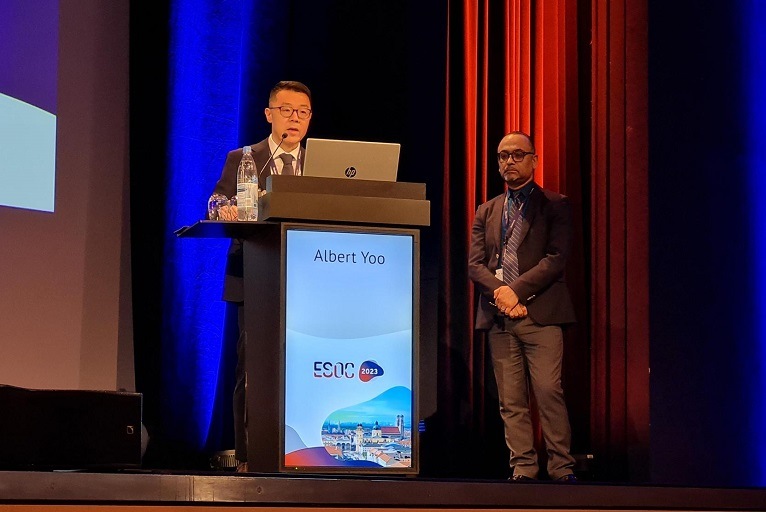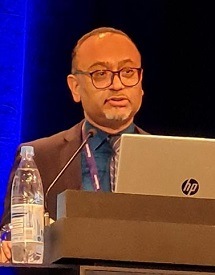
The results of the TESLA trial were recently presented at the European Stroke Organisation Conference (ESOC; 24–26 May, Munich, Germany), demonstrating a “strong suggestion” across several domains that endovascular therapy (EVT) can provide benefits over best medical management (BMM) in large-core infarct stroke patients—despite the intervention narrowly failing to reach its prespecified superiority threshold.
Late-breaking findings from TESLA were delivered by Albert Yoo (Texas Stroke Institute, Plano, USA) and Osama Zaidat (Mercy Hospital, Toledo, USA), with Yoo initially outlining the three already-published randomised controlled trials (RCTs)—RESCUE-Japan LIMIT from Japan, ANGEL-ASPECT from China, and SELECT2 from North America, Europe, Australia and New Zealand—that have indicated safety and functional outcome benefits with EVT in large-core infarct stroke.
The TESLA study—a prospective, multicentre, assessor-blinded RCT with adaptive-enrichment design—set out to build on these findings, but chose to home in on large-core infarct patients identified using non-contrast computed tomography (NCCT) imaging only, as opposed to advanced imaging evaluations. Yoo commented that this is likely to make the trial’s results “highly generalisable”, as NCCT is available at all stroke centres. He further noted that the three aforementioned studies were all restricted to patient populations with Alberta stroke programme early CT score (ASPECTS) 3–5, whereas TESLA included patients with ASPECTS 2–5.
A total of 302 acute ischaemic stroke patients with an anterior circulation large vessel occlusion, presenting within 24 hours from time last known well, were randomised to receive either EVT plus BMM or BMM alone across 47 US sites. TESLA’s primary efficacy endpoint was the difference in distribution of 90-day utility-weighted modified Rankin scale (UW-mRS) scores between the two treatment arms, while its primary safety endpoint was 90-day mortality. Key secondary endpoints included 90-day ordinal mRS shift, mRS 0–2, mRS 0–3, and 24-hour symptomatic intracranial haemorrhage (ICH), according to Yoo.
The investigators reported that the study’s intention-to-treat (ITT) population consisted of 152 patients in the EVT group and 148 in the control group—a “very good” follow-up rate for an RCT of almost 100% that was “better than expected”. Assessing TESLA’s primary endpoint in this population, they found a treatment benefit with EVT, as the intervention led to an average 90-day UW-mRS of 2.93 compared to 2.27 with BMM. However, Zaidat reported that this meant EVT had a Bayesian probability of superiority of 0.957 over the control arm, falling just short of the prespecified threshold of >0.975 needed to declare efficacy.

Discussing secondary endpoint outcomes in the ITT population, Zaidat said that the most notable benefits with EVT versus BMM came regarding major neurological improvement (National Institutes of Health stroke scale [NIHSS] score 0–2 or improvement of ≥8 points), which was observed at a rate of 26% in the intervention group and 13% with controls. He also highlighted a “strong suggestion” in favour of EVT versus controls regarding the rate of mRS 0–3 (30% vs 20%) and average quality-of-life scores.
The speaker informed the ESOC audience that there was “no significant modification” of the effect of EVT across any of the ITT subgroups, and that the point estimates for ASPECTS 2–3 and 4–5 were “similar”. Despite this, he did highlight possible signals favouring EVT in a number of these subgroups, including in females and patients whose occlusion was located in the internal carotid artery (ICA).
Zaidat then went on to deliver more positive results supporting the efficacy of EVT solely in the cohort of ITT patients whose NCCT ASPECTS 2–5 was determined by a core lab (131 in the intervention group and 118 in controls). A 90-day UW-mRS of 3.15 with EVT and 2.32 with BMM led to a Bayesian probability of superiority of 0.98 in this prespecified secondary analysis, eclipsing the primary-endpoint threshold of >0.975.
Zaidat also relayed that EVT was associated with “no major safety concerns” with respect to all-cause mortality at 90 days or symptomatic ICH at 24 hours, nor neurological deterioration within 5–7 days/at discharge or rates of decompressive hemicraniectomy, adding that there was therefore “almost no difference across the four major safety factors we look at in most [stroke] trials”. However, EVT was found to be associated with higher rates of type 1 and 2 parenchymal haematomas, type 1 haemorrhage infarctions, and subarachnoid haemorrhages.
Concluding, Zaidat opined that future research should focus on individual, patient-level meta-analyses of TESLA and the other major large-core infarct RCTs to “address patient selection based on NCCT” and “confirm outcomes with this pragmatic approach”, as the larger sample size these trials will combine to offer “might identify potential thresholds of futility” when using only NCCT ASPECTS. In addition, he said that comparisons between site- and core lab-read ASPECTS across other trials may clarify the extent to which “interobserver disagreement” impacts results.













